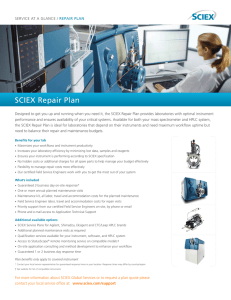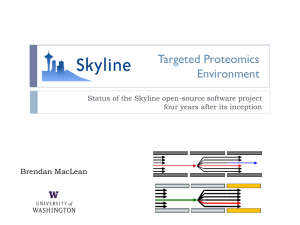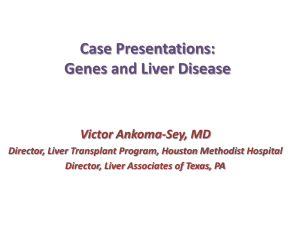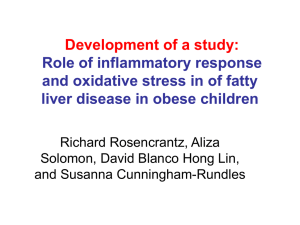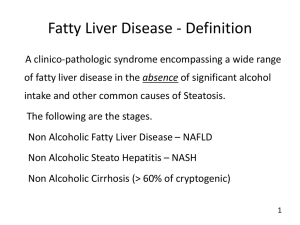This is AB SCIEX
advertisement
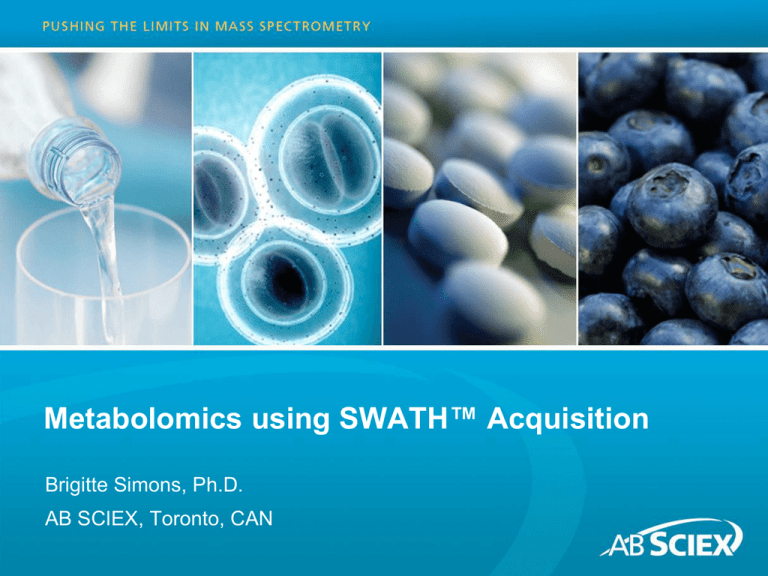
Metabolomics using SWATH™ Acquisition Brigitte Simons, Ph.D. AB SCIEX, Toronto, CAN Non-Alcoholic Fatty Liver Disease Lipid Profiling of Liver Tissue Research Study Non-alcoholic fatty liver disease (NAFLD) includes the manifestation of non-alcohol steatohepatitis (NASH) and hepatic steatosis (SS) PC/PE ratio can provide monitoring of the integrity of hepatocyte cell membranes and an important marker in NAFLD pathogenesis Fatty acid profile can provide insights into hepatic enzymatic activity and fat metabolism Puri, P., Wiest, M.M., Cheung, O., Mirshahi, F., Sargeant, C., Min, H.K., Contos, M.J., Sterling, R.K., Fuchs, M., Zhou, H., et al. 2009. The plasma lipidomic signature of nonalcoholic steatohepatitis. Hepatology 50:1827-1838. 2 © 2012 AB SCIEX NAFLD and Lipid Analysis Changes in FA composition has been shown in NAFLD vs. controls – Lower n-6 and n-3 PUFA, n6/n3 ratio higher – Due to oxidative stress, altered desaturase activity (Allard et al. 2008 J Hepatol; Puri et al. 2007 Hepatol; Araya et al. Clin Sci 2004) Liver: Lower amount of PC associated with steatosis, but lower PC/PE ratio with inflammation (Li et al. Cell Metab 2006) Fatty Liver in the ob/ob mouse model: – Decreased number of correlations among lipid species, showing decreased co-regulation – Short, medium chain TAG and ceramides (Yetukuri et al. 2007 BMC Syst Biol) Adipose tissue in adipose women with/without fatty liver: – 154 lipid species significantly altered – Especially TAG, particularly long chain, and ceramides, specifically Cer(d18:1/24:1) (Kolak et al. 2007 Diabetes) 3 © 2012 AB SCIEX Study Design Cross-sectional study Including patients with NAFLD (n=28), chronic Hepatitis C (n=13) and healthy living liver donors as controls (n=9) Lipidomic analysis (including PC/PE ratio) in liver tissue Other measurements: Demographics, anthropometry, dietary intake 4 © 2012 AB SCIEX Molecular Lipidomics Platforms H.R. Jung et al. (2011) Biochimica et Biophysica Acta; 1811; 925-937 • 150 μl liver homogenate (containing 0.15 – 2.49 mg of liver tissue) mixed with 4 ml of chloroform: methanol (2:1) (v/v) with 0.02% butylated hydroxytoluene as antioxidant • 1 part aqueous (sample extract), 2 parts MeOH, 0.9 part CH2Cl2; Add 1 part H2O, 1 part CH2Cl2, 10 mM LiCl; Vortex & spin - take lower layer • Lipids were diluted with chloroform to 0.08 mg/mL final concentration and diheptadecanoyl PC and PE were added as internal standards at 0.15 μmol/L final concentration. • Samples were further diluted 1:1 with chloroform:methanol (1:2, v/v) with 5 mM ammonium acetate and analyzed by nanoelectrospray infusion tandem mass spectrometry 5 © 2012 AB SCIEX Shotgun Lipidomics of Human NAFLD Liver Tissue Lipid Profiling of Complex Extracts by Direct Infusion Clinical lipid biopsies: healthy controls = 9 samples ; NAFLD = 28 samples; CHC = 13 >30 min < 1 min Total lipid extracts Automated sample infusion Liver Biopsies Advion NanoMate TriVersa Multiple Precursor Ion Scanning 3.1 min per sample QTRAP® 5500 System Lipid identification and quantification 30 min analysis time LipidView™ Software Result reporting Infusion-quantitation Ekroos, K et al., Methods in Pharmacology and Toxicology: Biomarker Methods in Drug Discovery and Development, Humana Press 2008 Ståhlman, M et al. High-throughput shotgun lipidomics by quadrupole time-of-flight mass spectrometry, J Chrom B 2009 Arendt et al., Non-alcoholic fatty liver disease is associated with lower hepatic and erythrocyte ratios of phosphatidylcholine to phosphatidylethanolamine, Applied Physiology, Nutrition and Metabolism, Oct 2012. 6 © 2012 AB SCIEX Multiplexed Precursor Ion Scanning [XPIS] Scan Precursors CAD Select lipid-specific fragment Full range Q1 scan Exp 1 m/z Q1 LINAC Q2 Q3 Exp 2 Technical benefits of Multiplexed Precursor Ion Scanning [XPIS] for lipid quantitation m/z – All desired lipid classes and their internal standards are detected in parallel looped acquisitions Spectra are directly interpretable and can be overlaid for Exp 3 comprehensive lipid characterization Transitioning from PIS to MRM can be easily achieved for m/z highly multiplexed and robust relative lipid quantitation 7 2012 AB SCIEX Ekroos, K et al. Analytical©Chemistry 2002. Technical Benefits of Multiplexing PIS Precursor Fragmentation Profiles Are Overlaid for Lipid Species Characterization and Quantitation PE 38:4 8 © 2012 AB SCIEX Hepatic PC/PE Ratios Calculated Individually Per Patient by IS Corrected Peak Area Ratios Mean = 3.27 ± 0.60 Mean = 1.25 ± 0.79 9 Arendt et al., Non-alcoholic fatty liver disease is associated with lower hepatic and erythrocyte ratios of phosphatidylcholine to phosphatidylethanolamine, Applied Physiology, Nutrition and Metabolism, Oct 2012. © 2012 AB SCIEX Hepatic PC Measured by IS Corrected Peak Area Ratios 10 © 2012 AB SCIEX Hepatic PE Measured by IS Corrected Peak Area Ratios 11 Arendt et al., Non-alcoholic fatty liver disease is associated with lower hepatic and erythrocyte ratios of phosphatidylcholine to phosphatidylethanolamine, Applied Physiology, Nutrition and Metabolism, Oct 2012. © 2012 AB SCIEX Multiplexed Precursor Ion Scanning on the QTRAP® 5500 System Enabling Up to 60 Precursor Ion Experiments Scanned in Parallel in Both Polarities Liver Tissue Lipid Extract 12 RBC lipid extract © 2012 AB SCIEX The advent of High Resolution MS in metabolomics… – Improved the quality and confidence in the answers obtained – By providing elemental formula confirmation, isotope pattern match – Accurate mass fragment information for improved structure interpretation – Enable simultaneous Qualitative and Quantitative data collection – Stream lined a generic data collection practice of MS and NOW MS/MS simultaneously ….MS/MS data simultaneously collected is advantageous yet reproducibility and remains challenging – Targeted MS/MS data collection is still the best in terms of selectivity – But not realistic in discovery mode – Automated data collection using IDA imposes prioritization – Mass defect filters, isotope filters, background subtraction… – Very effective, but each compound requires its own MS/MS trigger point – MSall (or MSe) can make acquisition more generic – But this approach heavily relies on LC separation capability – Related compounds (drugs, inhibitors, activators) can easily be handled by UPLC – But endogenous matrix species can increase complexity beyond UPLC’s capability – Multiple co-eluting species can complicate the MSMS information if no precursor selection occurs 13 AB Sciex Confidential ASMS 2012 – AB Sciex User Meeting © 2011AB ABSCIEX SCIEX © 2012 SWATH™ Acquisition What is it? MS/MSALL – A unique data-independent workflow enabled by TripleTOF® system technology that acquires high resolution quantifiable MS/MS data for all detectable analytes in a complex sample, in single run How does it work? SWATH™ Acquisition – Use of a wide isolation window stepping across a mass range, collecting high resolution MS/MS spectra in a chromatographic time scale – Data processing via post-acquisition fragment ion XICs at high resolution for quantitation of thousands of peptides and confirmation of identity 14 © 2012 AB SCIEX Comprehensive Quantitation cycle time ~ 2.5 s Wide Q1 isolation (25 Da) TripleTOF speed allows full coverage of mass range High resolution XIC data for m/z all fragment ions SWATH = 25 Da retention time 15 © 2012 AB SCIEX Metabolite Fishing…. Acylcarnitine Profiling in CSF Extracts Accurate mass XICs of all 48 targeted acylcarnitine species XIC quant Summary Table 16 © 2012 AB SCIEX Acylcarnitine Quant Summary with Confirmation SWATH for Targeted Screening Acylcarnitine C18 C25H49NO4 17 MS/MS for confirmation © 2012 AB SCIEX Acylcarnitine Profiling in MeOH CSF & Plasma Extracts MarkerView Software for PCA and Multivariate Statistical Analyses Plasma CSF 18 © 2012 AB SCIEX Comprehensive Quant/Qual Metabolomics SWATH™ Acquisition IDA for Metabolite Screening Feature statistical alignment MRM Quantitation of Every Metabolite unknown compound identification XIC Manager Quantitative 19 Fast targeted or untargeted XIC generation Qualitative © 2012 AB SCIEX Metabolite Identification and Confirmation Against Accurate Mass Libraries Retention Time Mass Accuracy Isotope Pattern 20 Library high and Purity Score © 2012 AB SCIEX Data Independent SWATH MS for Lipidomics Full MS/MS Archive of Every Compound in the Sample Direct infusion, flow injection, and lipidclass targeted LC techniques Q1 Q2 Fast Q1 precursor selection step-wise through mass range CID Fragmentation Collection of High resolution MS/MS 21 © 2012 AB SCIEX MS/MSALL Acquisition Method Set-up cycle time ~ 3.3 min 1200.051 200 - 1200 (m/z) 705.555 704.554 703.553 Q1 mass filter width = 0.7 Da 702.552 701.551 700.550 200.0550 acquisition time 22 © 2012 AB SCIEX 450 Human Plasma Lipids Profiled in 6 min using SWATH™ Acquisition TAG, 52 PE, 43 PG, 14 DAG, 23 PI, 27 FFA, 24 PC, 62 PS, 16 MAG, 18 CE, 15 132 LPI, 1 SM, 36 PA, 27 257 PE O, 25 LPA, 7 LPE, 12 LPC, 12 67 PC O, 29 PI O, 1 PA O, 4 23 PS O, 2 PG O, 2 LPC O;4 Diacyl phospholipids Ether-linked/plasmalogen phospholipids Storage lipids *Data processed by LipidView™ Software © 2012 AB SCIEX Infusion SWATH of Human Plasma Total Ion Map PE 18:0/20:4 PI 18:0/20:4 24 © 2012 AB SCIEX Infusion SWATH Configuration Method Set-up 1. Bligh-Dyer extraction with surrogate standard cocktail 2. Infuse sample (µM) in 4:2:1 IPA/CHCl3/MeOH (10mM NH4OaC) 3. Positive and Negative TOF MS Calibrant delivery (APCI) ESI and MS/MSALL acquired sequentially in 3.3 minutes 4. Data analysis, quantitation, results interpretation Shotgun Lipidomics by Sequential Precursor Ion Fragmentation on a Hybrid Quadrupole Time-of-Flight Mass Spectrometer Simons B, Kauhanen D, Sylvänne T, Tarasov K, Duchoslav E, Ekroos K. Metabolites 2012, 2, 195-213. 25 © 2012 AB SCIEX MS/MS for Lipid Identification + MS/MSALL measured mass: [C45H80NO8P+H]+ theoretical mass: 794.5694 mass error: 0.5 ppm Intensity, cps measured mass: [C46H84NO7P+H]+ theoretical mass: 794.6058 mass error: 0.6 ppm - MS/MSALL 26 © 2012 AB SCIEX Definitive Lipid Molecular Species Identification Only MS/MS pos and neg spectra combined provide the distinguishing fragments to identify PC 37:5, PC O-38:5, & PE 40:5 27 © 2012 AB SCIEX Lipid Relative Quantification of CER d17:0/17:0 Corrected by CER d17:1/18:0 IS Quantitative Performance of a QqQ Instrument Cer d17:1/18:0 1000 Shg 5600 Shg 5500 LC-MRM 4000 Peak intensity ratio of m/z 250.25 / m/z 264.27 Cer d17:1/18:0 100 R2 > 0.994 Shg 5600 Precursor Ion scanning on Shg5500 5500 QTRAP System LC-MRM on 4000 QTRAP System LC-MRM 4000 MS/MSALL on TripleTOF® System 10 ® ® 1 0.1 0.0001 0.001 0.01 0.1 1 10 Concentration, µM 28 Shotgun Lipidomics by Sequential Precursor Ion Fragmentation on a Hybrid Quadrupole Time-of-Flight Mass Spectrometer © 2012 AB SCIEX Simons B, Kauhanen D, Sylvänne T, Tarasov K, Duchoslav E, Ekroos K. Metabolites 2012, 2, 195-213. concentration, µM TAG Lipid Profiling in Plasma 0 100 +MS TAG 52:3 +MS/MS of TAG 52:3 NL 18:0 200 Group A 29 Group B Group A Group B © 2012 AB SCIEX LC MRM 30 © 2012 AB SCIEX Acknowledgments University of Toronto & Toronto General Hospital – – – – Johanne Allard Bianca Arendt Elaheh Aghdassi David Ma VTT Technical Research Institute of Finland – Kari Raino 31 Zora Biosciences, Fi – Kaisa Koistinen – Kim Ekroos AB SCIEX – – – – – Ron Brejak Paul Baker Dan Puscasu Eva Duchoslav Gary Impey © 2012 AB SCIEX Questions and Answers 32 © 2012 AB SCIEX Trademarks/Licensing For Research Use Only. Not for use in diagnostic procedures. The trademarks mentioned herein are the property of AB Sciex Pte. Ltd. or their respective owners. AB SCIEX™ is being used under license. © 2012 AB SCIEX. 33 © 2012 AB SCIEX TripleTOF® 5600+ System Publically Available Application Data and Publications Lipidomics and Metabolite Identification 34 © 2012 AB SCIEX Conclusion MS/MSALL with SWATH™ Acquisition is a novel data-independent acquisition strategy that provides: – Comprehensive high resolution MS/MS data for all detectable ions – High quality quantitation similar to MRM with no method development – Easy and retrospective data interrogation SWATH Acquisition is ideal for quantifying extremely large numbers of peptides in complex samples – Biomarker verification – Network biology SWATH data can be processed by PeakView and MarkerView or extracted for use with 3rd party informatics tools 35 © 2012 AB SCIEX
